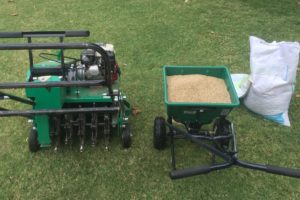
Aeration Allows You to Water Less
Aeration helps reduce the frequency of watering because the roots are now receiving the amount needed.
Aeration Increases Your Turf Health
Because of aeration the root system gets more access to air, sun, water, nutrients and fertilizer. This will cause the roots to grow deep and to spread out more for an overall healthier lawn
Aeration Decompacts Your Lawn
Aeration breaks up the soil to decrease the density and let nutrients be absorbed.
Aeration Increases Your Lawn’s Stress Tolerance
Aeration helps your lawn be tolerant to heat and drought stress
What to Expect From Your Aeration Service
Many people seem to think that since aerating is good for the lawn, then there’s nothing wrong with doing it often. Frequent aeration can actually damage the health of your yard by damaging turf grass roots. This is why your service suggests spring and fall aeration; this is the optimal time for root development. Your technician will go around your yard with a machine and aerate your lawn. Be sure to have items such as tools, toys and clutter removed to help the process go smoother. Your lawn will get a little messy because when the job is completed there will be little plugs of soil all over the lawn. The machine pulls little plugs of soil out of the lawn. This is normal and the little plugs will dissipate over time.
In Addition to Aeration Apply Lime
Lawn Aeration is most effective when performed by experts. Professionals understand that compacted turf will not thrive and any new seeds you may plant will not take root. Your professional will probably suggest that after aeration you apply lime . The reason being that after aeration there is plenty of open access to get the agent deep down in the soil. Liming raises the pH level and reduces soil acidity. This helps to make soil more favorable for turf grass growth.Fall is especially beneficial as freeze and thaw cycles help accelerate the breakdown of lime for lawns and put it to work.
Reasons for Applying Lime
- Lime nourishes essential bacteria. It helps your lawn by providing nourishment to good bacteria present in your soil.
- It adds Nutrients. Calcium carbonate is lime’s main component in the form of limestone.
- These nutrients help to preserve your lawn’s color and lushness. The calcium, and magnesium from lime help with drought, heat or high traffic.
- Lime neutralizes the pH level. Lime will neutralize this acidity by dissolving, whereupon it releases a base into the soil solution that reacts with the acidic components, hydrogen and aluminum.
- Soil pH is an indicator of “soil acidity”. A pH of 7.0 is defined as neutral.
Your professional will test your pH to determine the amount of lime and number of applications are needed to properly balance your pH level.
A&A Has You Covered!
Aeration | Learn More
Overseeding | Learn More
Contact Us (859-384-0266) for a Free Consultation!
—
 About A & A Lawn Care & Landscaping
About A & A Lawn Care & Landscaping
A & A Lawn Care & Landscaping can beautify your lawn and landscaping using our vast experience in turf grass management. Our complete lawn service is designed for both residential and commercial lawns and we keep your lawn healthy without harming your family, staff, or pets.
>> Learn More

 About A & A Lawn Care & Landscaping
About A & A Lawn Care & Landscaping